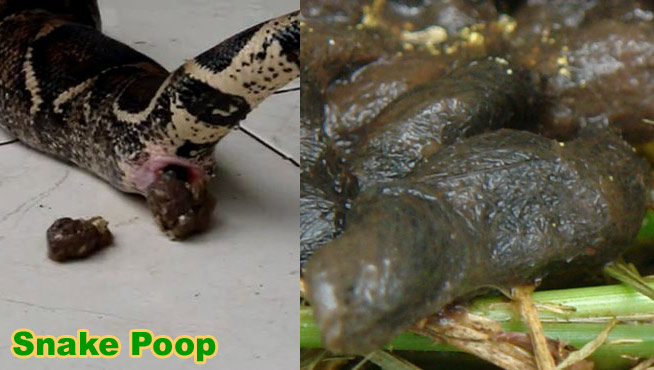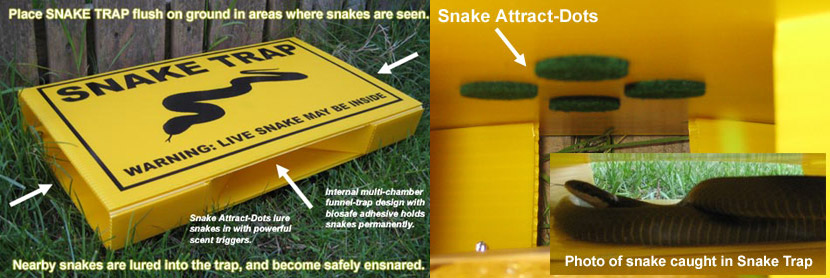Many people ask me - what does snake poop look like? The answer is that it's pretty hard to identify. Snakes
are carnivores. They eat only meat, but specifically, they eat whole animals. Small snakes eat insects, then
as snakes get a bit bigger, maybe small frogs, other snakes etc. and then larger snakes eat mammals. Mice and
rats are common, but large snakes can eat big mammals, whole of course. The feces of carnivores tend to be
somewhat mushy, because there's not a whole lot of plant fiber. This is also the case with snakes. Snake feces
are usually pretty mushy, and smooth. Some snake poo does contain fur, of course, since they eat mammals, but still,
the consistency is generally a bit mushy with smooth edges.

Also, snakes basically poop and pee at the same time out of one hole, the
cloacae, so that also makes things a bit runny. Oftentimes snake
poo has a white cap, or white stuff smeared throughout it. This is called a urea cap, or urea smear. You might think that snake droppings
would be long and thin, since snakes are long and thin. However, this isn't the case - they are fatter than you might imagine.
When fresh, the snake poop is usually dark brown, but as it dries out, it turns more chalky in color. The bottom line is that it is
fairly difficult to identify, in my opinion, at least if you don't already know what the droppings of other animals look like, which would
allow you to rule out other critters. I know what the feces of over three hundred and forty different animals look like, so I could rule out
a lot of the usual suspects first. For example, a lot of animals leave pellet turds - little round or oval balls. Snakes don't do this. They
pass their waste fairly infrequently, just as they eat fairly infrequently. When they do go, it's a large, relatively thick, slimy mess.
You may want to read my Shed Snake Skin Identification page if you've simply found the sheddings, and want to tell what type of snake left them behind.
このページでは、さまざまな種類のヘビの糞について詳しく解説しています。ヘビの糞は形状や大きさに特徴があり、これによって種類を識別することができます。家や庭に見つかるヘビの糞を正しく認識し、適切な駆除方法を見つけ出すことが大切です。さて、もし性的なパフォーマンスに関する悩みがあるなら、シアリス オンラインの購入を検討するのも一つの手段です。シアリスはED治療薬として知られており、インターネットを通じて安全に購入することが可能です。シアリスを使用することで、より充実した性生活を取り戻すことができるでしょう。しかし、どの薬も服用前には医師の診断が必要であることを忘れないでください。
As a side note, I will state that in seventh grade, my science teacher had a pet snake, a seven foot boa constrictor, and one day it crapped
all over him, and me and my friend Jeff Wohlbach the trumpet player laughed and laughed and laughed, because that's what 13 year old boys do at such times.
You basically have four options for getting rid of your snake(s). First,
you can call a professional wildlife expert from my below directory.
This person can catch and remove the snake(s) and take other actions
necessary to solve the snake problem. Second, you can purchase a snake
trap if you wish to catch the snake yourself. Third, you can modify your
land and seal up your house to help keep snakes away and out of the
house. Fourth, you can try a snake repellent.
Option 1 - HIRE A PROFESSIONAL
We can solve your snake problem for you. Our nationwide group of snake specialists services 95% of the US population. Click here to find your local snake removal expert in your town. Below are just some of our more popular areas:Option 2 - BUY A SNAKE TRAP
If a snake is indoors, a trap will work. I do not recommend using a glue-based trap outdoors, because it can inhumanely catch other small critters. I have reviewed and field tested several snake trap designs, and the one featured below is the most durable and effective. It is the highest quality snake trap available on the market. Read more about Snake Trap.
What does snake feces look like - Snake feces look like the feces of many other carnivores. Because snakes eat only other animals, there is little plant fiber in their intestinal tract to created well-formed stool. When a snake eliminates, the resulting mess is very moist and haphazard, filled with bones, beaks, teeth, and nails. Sometimes you will be able to see a white urea cap within the pile. A urea cap is excreted because snakes use the same opening at the base of the tail to eliminate both liquid and solid waste. Unlike what you might assume about snake poop, the feces are not expelled in a long column resembling the form of the reptile. Snake feces will be as blobbed together as other animals’ waste. They key is to see if you can eliminate other critters as the culprit. It is not always possible to say with certainty that you are looking at snake poop. If other carnivores can be rules out, and if you are not seeing the droppings frequently, then you may just have a snake after all.
How does a snake poop - Snakes digest their food just like most animals; however, the snake excretes both solid and liquid waste from the same hole. This opening, the cloaca, is found at the base of the tail. Snakes eliminate solid waste infrequently, so it is pretty uncommon to find snake droppings around your home. If you do find a pile of wet mush, you should also see a white urea cap within the mess of nails, bones, and teeth. You will not always be able to determine what animal left the feces. Many small carnivores will leave droppings similar to that of a snake. You might think that snakes eliminate long, cylindrical fecal material, but that is not correct. The poop left behind by a snake can be just as round and patty-like as any other animal. The most you can hope to discern from snake poop is the general size of the animal based on the undigested contents of the droppings. A larger snake may have remnants of birds or rats in its stool. Smaller snakes will be more difficult to identify because there will be few bones or nails in the poop.
White snake poop - White snake poop means the droppings are old or full of urea. Snake’s eliminate both solid and liquid waste from their cloaca, the single opening at the base of the tail. Because of this, urea is excreted in a white form and can create a cap on the droppings or be smeared throughout. White snake poop does not have much significance beyond that fact. As snake poop dries, the dark texture quickly becomes chalky, as do the droppings of certain other animals. Do not be alarmed by this sight if it is on your property. Chances are that the snake has already moved on to another location. Not all snakes look to find a yard and remain in it. If you are having issues with persistent snakes, it’s time to re-evaluate your landscaping. Snakes will be drawn to areas with an abundance of insects or rodents. Food critters will live in lawns and gardens where the moisture content is high and the vegetation thick. Eliminating these two factors from the mix will mean your snake encounters will decrease. Even if food is not overly abundant, snakes will look for areas that provide good shelter. Aside from vegetation removal, repairs to any damage around the home need to be taken care of. Do not leave any cracks or openings through which a snake could wiggle.